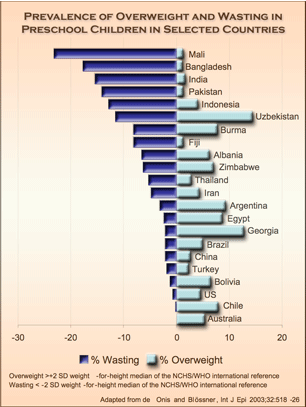CECHE  Center for Communications, Health and the Environment
Center for Communications, Health and the Environment
 Center for Communications, Health and the Environment
Center for Communications, Health and the Environment 
Partnerships Promote Global Health
Obesity Scourge Spreads Unchecked
by Anna Ferro-Luzzi and Pekka Puska, World Health Organization, Geneva

The Epidemic
The magnitude of the problem is staggering. Recent analysis reveals 1 billion overweight people worldwide. And one in three of them – 300 million men and women – are clinically obese. (World Health Report 2002; www.who.int/whr)
The prevalence of obesity varies across countries. In Europe and the United States, 10 to 25 percent of the population is obese, while in Brazil, 6 percent of men and 13 percent of women tip the scales. In Western Samoa, obesity affects 77 percent of urban women, and it is a fact of life for 44 percent of black women in the Cape Peninsula of the Republic of South Africa. In general, obesity is highest among lower-income populations in developed countries, and among more affluent people in developing ones.{
Undernutrition and Childhood Obesity Together Deliver Potent Punch Worldwide
by Prof. Boyd Swinburn, Centre for Physical Activity and Nutrition Research,
Deakin University, Melbourne, Australia
 Seemingly unrelated, undernutrition and childhood obesity are actually intricately, and complexly, linked. Over the past 10 years, all but the poorest countries have experienced substantial increases in obesity prevalence, and in many low- to middle-income countries, obesity is overtaking undernutrition as the main national nutrition problem.
Seemingly unrelated, undernutrition and childhood obesity are actually intricately, and complexly, linked. Over the past 10 years, all but the poorest countries have experienced substantial increases in obesity prevalence, and in many low- to middle-income countries, obesity is overtaking undernutrition as the main national nutrition problem.Undernutrition On the Wane
Childhood undernutrition, or malnutrition, is a chronic problem in lower-income countries. A high prevalence (>40%) of stunting in children is present in sub-Saharan Africa and many countries in South-Central and Southeast Asia, while low (<20%) and moderate (20-30%) rates are seen in the majority of Latin American and Caribbean nations. Thankfully, in all developing countries combined, the prevalence of stunting has dropped considerably, from nearly 50 percent in 1980 to 30 percent in 2000, and it is projected to fall to about 16 percent by 2020. Unfortunately, African nations continue to suffer severely, with only about a 5 percent decline from 1980 to 2000.{